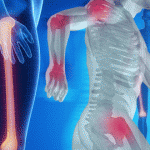The case presented included a description of the patient developing severe shingles while on treatment, and both Dr. Lundberg and Dr. Wang agreed that these patients are at high risk for infection and ideally should be vaccinated with Shingrix as soon as possible (although this vaccine can be very expensive for patients).
It was noted that many patients with anti-MDA-5 antibody-positive dermatomyositis have a particularly high risk of pulmonary infection, and Asian patients have a higher risk of severe lung involvement and infection risk with this condition.
On the subject of lung involvement, Dr. Lundberg pointed out that we do not have the data to show if treatment of the condition can help prevent the progression of ILD, and Dr. Wang indicated that the presence of lymphopenia, high ferritin level and high-titer anti-MDA-5 antibodies tend to be associated with a high risk of ILD.
Dr. Lundberg advised clinicians that when evaluating and re-evaluating patients with anti-MDA-5 antibody-positive dermatomyositis it may be necessary to repeat pulmonary function testing frequently to avoid missing progression of disease.
Muscle Weakness
In the second case presentation of the session, a 70-year-old man with a history of sarcoidosis presented with right proximal leg weakness and sensory loss in the lower limbs. His laboratory studies showed normocytic anemia, elevated creatinine, elevated C-reactive protein and elevated lactate dehydrogenase, with normal creatine kinase, negative myositis panel and slightly elevated myeloperoxidase antibody but negative anti-neutrophil cytoplasmic antibody (ANCA) panel.
Magnetic resonance imaging (MRI) of the thighs showed extensive myositis in the right quadriceps compartment (vastus lateralis). CT imaging of the chest, abdomen and pelvis showed several areas of lymphadenopathy. A muscle biopsy demonstrated numerous findings, including inflammatory changes that can be seen with immune-mediated myositis, fibrosis, a focus of granulomatous myositis, features of inclusion body myositis (IBM), strong major histocompatibility complex 1 (MHC1) positivity, focal MHC positivity and an increase in Cox-succinic acid dehydrogenase positive fibers. The differential for the diagnosis thus included chronic sarcoid myopathy, paraneoplastic myositis or IBM.
In discussing how to approach this complicated case, Dr. Lundberg noted that it is essential the muscle biopsy be reviewed by an experienced musculoskeletal pathologist. In addition, the treating rheumatologist should look at the slides together with the pathologist to understand the detailed findings.
Dr. Wang explained that this patient’s case could be one of polymyositis, immune-mediated necrotizing myositis or isolated muscular vasculitis. He raised the possibility that this patient could have ANCA-associated vasculitis involving the muscle, a rare but possible scenario.


